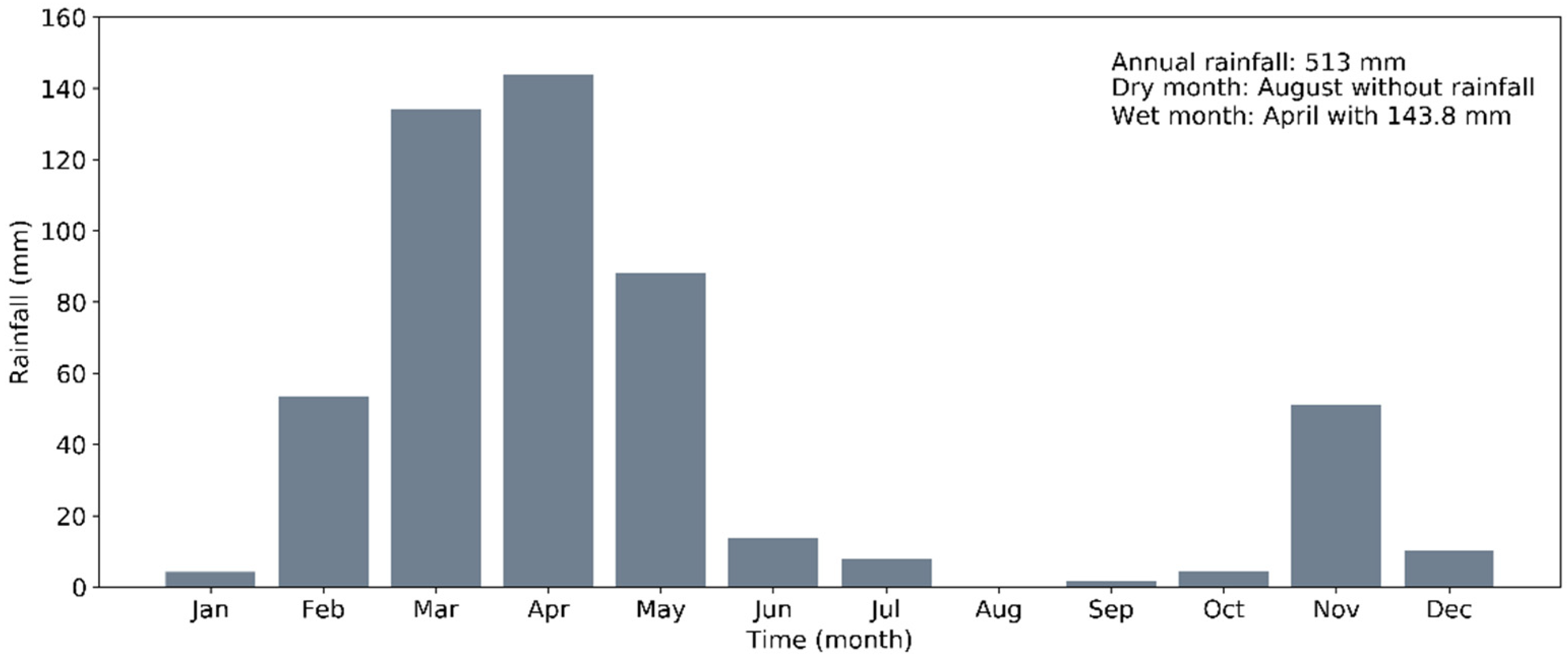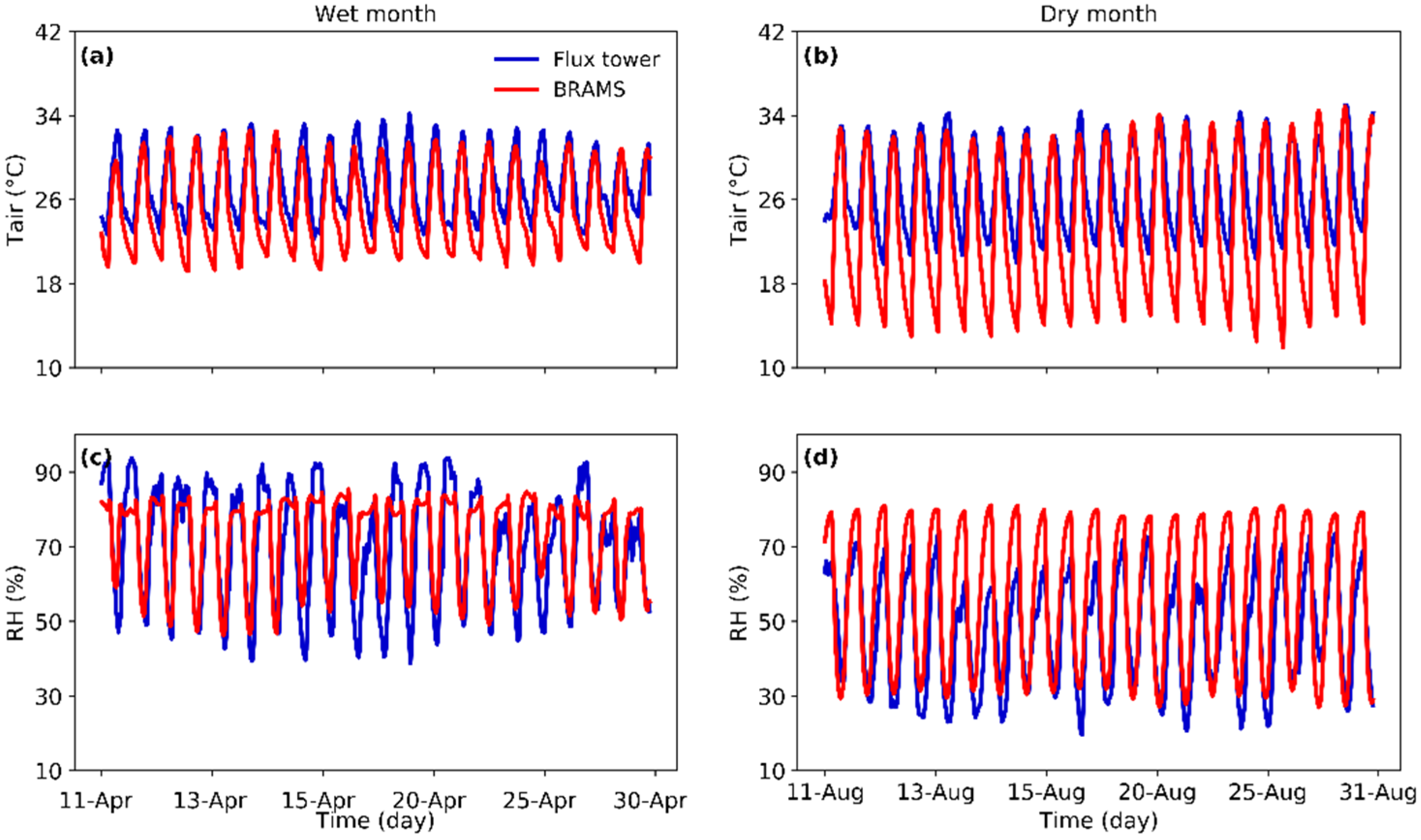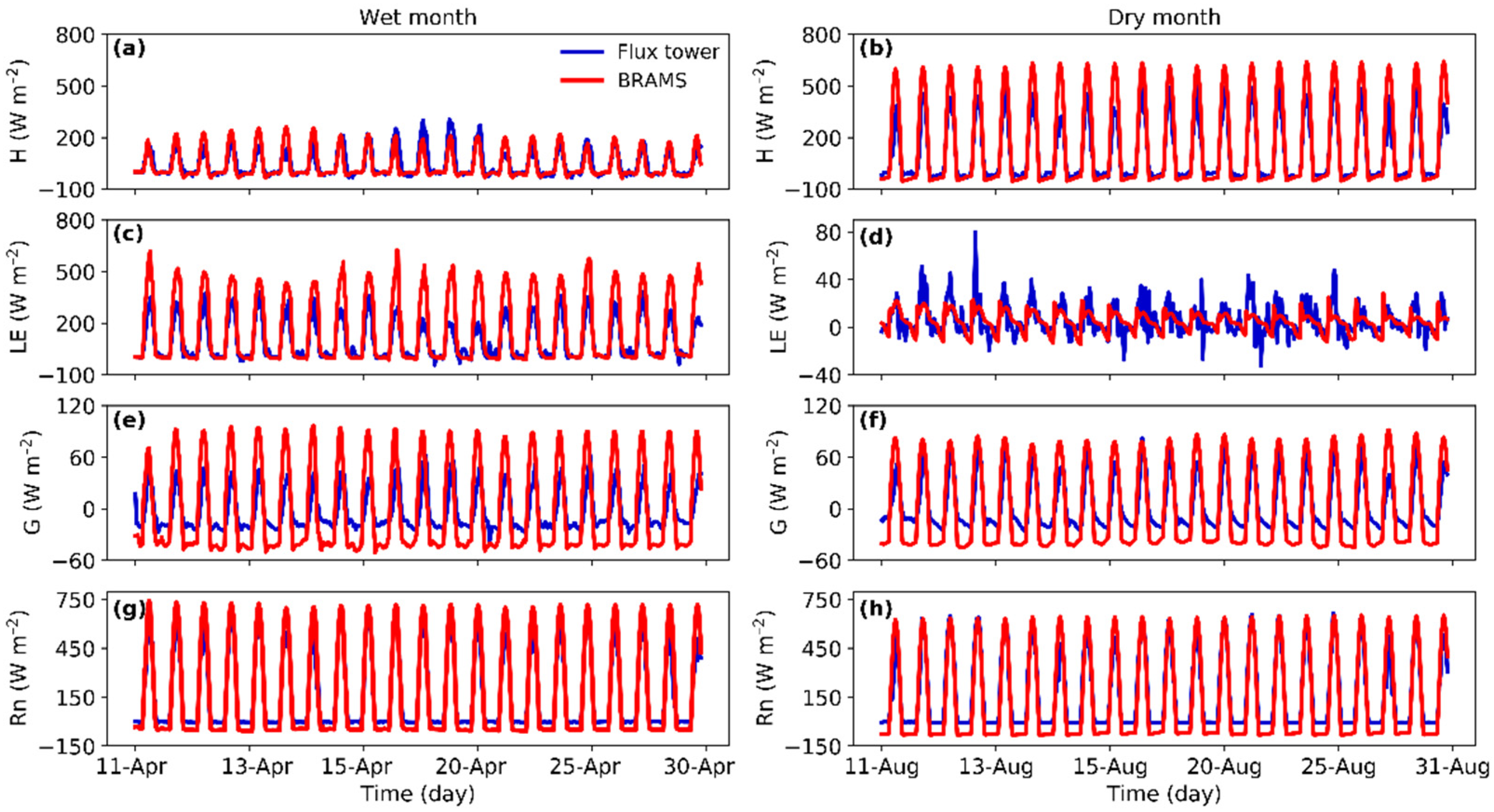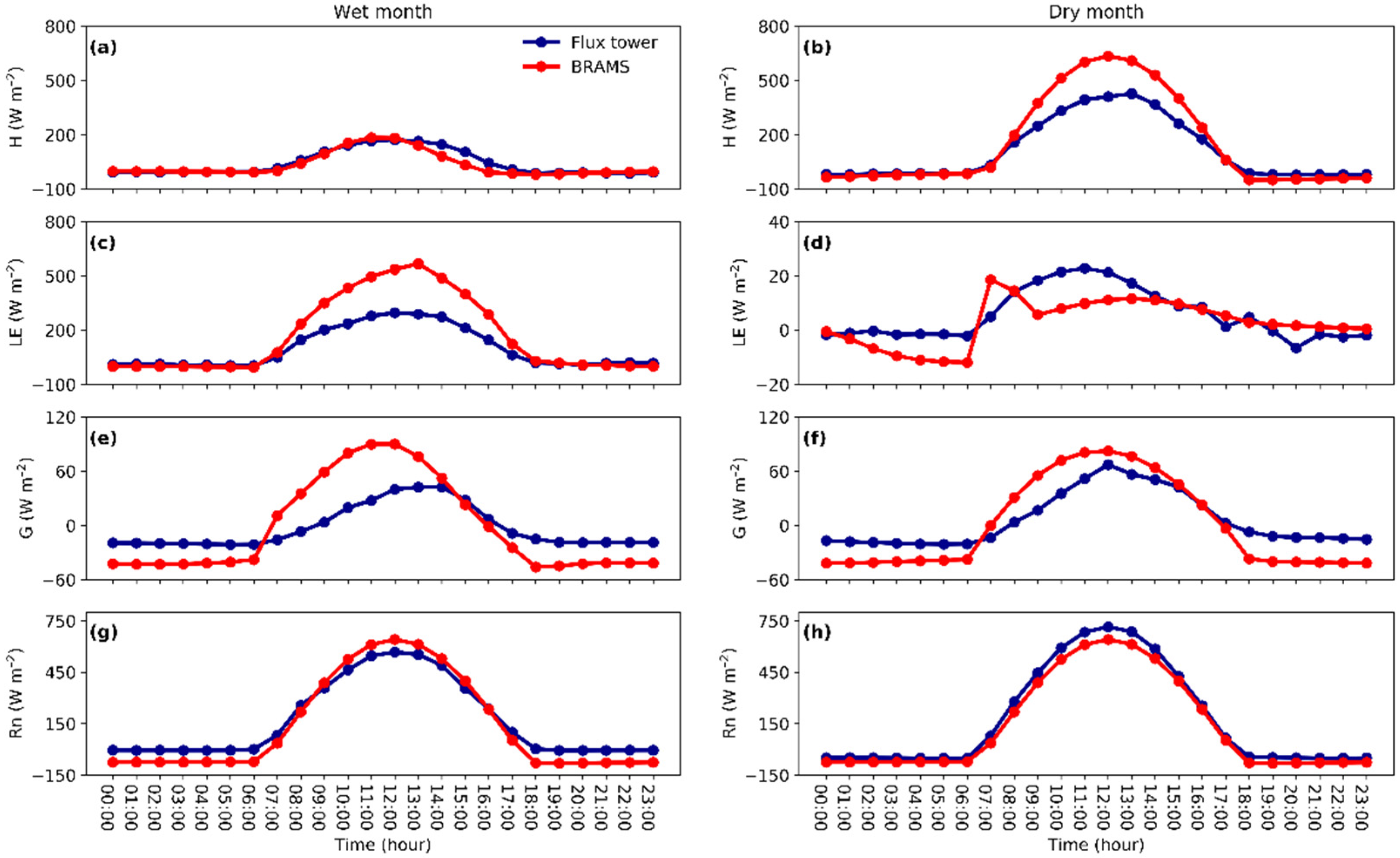Simulating Energy Balance Dynamics to Support Sustainability in a Seasonally Dry Tropical Forest in Semi-Arid Northeast Brazil
Abstract
1. Introduction
2. Material and Methods
2.1. Description of the Experimental Area
2.2. Observational Dataset
2.3. Dynamic Regional Model
2.4. Numerical Experiments
2.5. Analysis Tools
3. Results
3.1. Assessing the Model’s Performance for Rainfall Patterns
3.2. Surface Variables and Energy Fluxes
3.3. Daily Cycle in the Caatinga Biome
3.4. Statistical Analysis
4. Discussion
4.1. Rainfall Patterns and Model Performance
4.2. Surface Variables, Energy Fluxes and Daily Cycle in the Caatinga Biome
4.3. Performance and Improvements in the Simulation of the Caatinga Biome by the JULES/BRAMS Model
5. Conclusions
Author Contributions
Funding
Institutional Review Board Statement
Informed Consent Statement
Data Availability Statement
Acknowledgments
Conflicts of Interest
References
- Huang, J.; Ji, M.; Xie, Y.; Wang, S.; He, Y.; Ran, J. Global semi-arid climate change over last 60 years. Clim. Dyn. 2016, 46, 1131–1150. [Google Scholar] [CrossRef]
- Montenegro, S.; Ragab, R. Impact of possible climate and land use changes in the semi arid regions: A case study from North Eastern Brazil. J. Hydrol. 2012, 434, 55–68. [Google Scholar] [CrossRef]
- Souza, D.O.; Alvalá, R.C.; Nascimento, M.G. Urbanization effects on the microclimate of Manaus: A modeling study. Atmos. Res. 2016, 167, 237–248. [Google Scholar] [CrossRef]
- Araújo Filho, R.N.; Freire, B.G.S.; Wilcoxb, B.P.; Westb, J.B.; Ferreira, F.J.; Marques, F.A. Recovery of carbon stocks in deforested Caatinga Dry forest soils requires at least 60 years. For. Ecol. Manag. 2017, 407, 210–220. [Google Scholar] [CrossRef]
- Althoff, T.; Menezes, R.; Pinto, A.; Parey, C.; Carvalho, A.L.; Martins, J.C.R.; Carvalho, E.X.; Silva, A.S.A.; Dutra, E.D.; Sampaio, E. Adaptation of the century model to simulate C and N dynamics of Caatinga Dry forest before and after deforestation. Agric. Ecosyst. Environ. 2018, 254, 26–34. [Google Scholar] [CrossRef]
- Fernandes, M.F.; Cardoso, D.; de Queiroz, L.P. An updated plant checklist of the Brazilian Caatinga seasonally dry forests and woodlands reveals high species richness and endemism. J. Arid. Environ. 2020, 174, 104079. [Google Scholar] [CrossRef]
- Tavares-Damasceno, J.P.; de Souza Silveira, J.L.G.; Câmara, T.; Stedile, P.C.; Macario, P.; Toledo-Lima, G.S.; Pichorim, M. Effect of drought on demography of Pileated Finch (Coryphospingus pileatus: Thraupidae) in northeastern Brazil. J. Arid. Environ. 2017, 147, 63–79. [Google Scholar] [CrossRef]
- Falcão, H.M.; Medeiros, C.D.; Silva, B.L.R.; Sampaio, E.V.S.B.; Almeida-Cortez, J.S.; Santos, M.G. Phenotypic plasticity and ecophysiological strategies in a tropical dry forest chronosequence: A study case with Poincianella pyramidalis. For. Ecol. Manag. 2015, 340, 62–69. [Google Scholar] [CrossRef]
- Pires, W.N.; Moura, M.S.B.; Souza, L.S.B.; Silva, T.G.F.; Carvalho, H.F.S. Fluxos de radiacao, energia, CO2 e vapor de agua em uma area de Caatinga em regeneracao. Agrometoeros 2017, 25, 143–151. [Google Scholar] [CrossRef]
- Marengo, J.A.; Torres, R.R.; Alves, L.M. Drought in Northeast Brazil—Past, present, and future. Theor. Appl. Climatol. 2016, 129, 1189–1200. [Google Scholar] [CrossRef]
- Ribeiro, K.; Sousa-Neto, E.R.; Carvalho, J.A.; Lima, J.R.S.; Menezes, R.S.C.; Duarte-Neto, P.J.; Guerra, G.S.; Ometto, J. Land cover changes and greenhouse gas emissions in two different soil covers in the Brazilian Caatinga. Sci. Total Environ. 2016, 571, 1048–1057. [Google Scholar] [CrossRef]
- Mariano, D.A.; Santos, C.A.C.; Wardlow, B.D.; Allie, M.V.; Tadesse, T.; Svoboda, M.D. Use of remote sensing indicators to assess effects of drought and humaninduced land degradation on ecosystem health in Northeastern Brazil. Remote Sens. Environ. 2018, 213, 129–143. [Google Scholar] [CrossRef]
- Tomasella, J.; Vieira, R.M.S.; Barbosa, A.A.; Rodriguez, D.A.; Santana, M.O.; Sestini, M.F. Desertification trends in the northeast of Brazil over the period 2000–2016. Int. J. Appl. Earth Obs. Geoinf. 2018, 73, 197–206. [Google Scholar] [CrossRef]
- Alvalá, R.C.S.; Cunha, A.P.; Brito, S.S.B.; Seluchi, M.E.; Marengo, J.A.; Moraes, O.L.L.; Carvalho, M.A. Drought Monitoring in the Brazilian Semiarid Region. Ann. Braz. Acad. Sci. 2017, 91, 1678–2690. [Google Scholar] [CrossRef]
- Brito, S.S.B.; Cunha, A.P.M.A.; Cunningham, C.C.; Alvalá, J.A.; Marengo, M.A. Frequency, duration and severity of drought in the Semiarid Northeast Brazil region. Int. J. Climatol. 2017, 38, 517–529. [Google Scholar] [CrossRef]
- Cunha, A.P.M.A.; Alvalá, R.C.S.; Sampaio, G.; Shimizu, M.H.; Costa, M.H. Calibration and Validation of the Integrated Biosphere Simulator (IBIS) for a Brazilian Semiarid Region. J. Appl. Meteorol. Climatol. 2013, 52, 2753–2770. [Google Scholar] [CrossRef]
- Santos, M.G.; Oliveira, M.T.; Figueiredo, K.V.; Falcão, H.M.; Arruda, E.C.P.; Almeida–Cortez, J.; Antonino, A.C.D. Caatinga, the Brazilian dry tropical forest: Can it tolerate climate changes? Theor. Exp. Plant Physiol. 2014, 26, 83–99. [Google Scholar] [CrossRef]
- Falcão, H.M.; Medeiros, C.D.; Fonsêca, M.B.; do Espírito-Santo, M.M.; Santos, M.G.; Almeida, J.S. Variation in the water use and gas exchange of two Brazilian tropical dry forest phytophysiognomies in response to successional stage. J. Arid. Environ. 2022, 206, 104831. [Google Scholar] [CrossRef]
- Mendes, K.R.; Batista-Silva, W.; Dias-Pereira, J.; Pereira, M.P.; Souza, E.V.; Serrão, J.E.; Granja, J.A.A.; Pereira, E.C.; Gallacher, D.J.; Mutti, P.R.; et al. Leaf plasticity across wet and dry seasons in Croton blanchetianus (Euphorbiaceae) at a tropical dry forest. Sci. Rep. 2022, 12, 954. [Google Scholar] [CrossRef]
- Pinheiro, E.A.R.; Costa, C.A.G.; Araújo, J.C. Effective root depth of the Caatinga biome. J. Arid. Environ. 2013, 89, 1–4. [Google Scholar] [CrossRef]
- Silva, P.F.; Lima, J.R.S.; Antonino, A.C.D.; Souza, R.; Souza, E.S.; Silva, J.R.I.; Alves, E.M. Seasonal patterns of carbon dioxide, water and energy fluxes over the Caatinga and grassland in the semi-arid region of Brazil. J. Arid. Environ. 2017, 147, 71–82. [Google Scholar] [CrossRef]
- De Souza, C.A.A.; Jardim, A.M.D.R.F.; de Souza, L.S.B.; Júnior, G.D.N.A.; Alves, C.P.; de Morais, J.E.F.; de Carvalho Lopes, D.; Steidle Neto, A.J.; da Silva Salvador, K.R.; da Silva, T.G.F. Intercomparison of micrometeorological variables, surface energy fluxes, and evapotranspiration in different landscapes of the Brazilian semi-arid region. Agric. For. Meteorol. 2023, 341, 109679. [Google Scholar] [CrossRef]
- Silva, D.J.F.; Silva, T.R.B.F.; de Oliveira, M.L.; de Oliveira, G.; Mishra, M.; Santos, C.A.G.; da Silva, R.M.; Santos, C.A.C.D. Analysis of surface radiation fluxes and environmental variables over Caatinga vegetation with different densities. J. Arid. Environ. 2024, 222, 105163. [Google Scholar] [CrossRef]
- Silva, C.O.F.; Teixeira, A.H.C.; Manzione, R.L. Agriwater: An R Package for Spatial Modelling of Energy Balance and Actual Evapotranspiration Using Satellite Images and Agrometeorological Data. Environ. Model. Softw. 2019, 120, 104497. [Google Scholar] [CrossRef]
- Campos, S.; Mendes, K.; Silva, L.; Mutti, P.; Medeiros, S.; Amorim, L.B.; Santos, C.A.C.; Perez-Marin, A.; Ramos, T.; Marques, T.V.; et al. Closure and partitioning of the energy balance in a preserved area of a Brazilian seasonally Dry tropical forest. Agric. For. Meteorol. 2019, 271, 398–412. [Google Scholar] [CrossRef]
- Ferreira, R.R.; Mutti, P.; Mendes, K.; Campos, S.; Marques, T.; Oliveira, C.; Gonçalves, W.; Mota, J.; Difante, G.; Urbano, S.; et al. An assessment of the MOD17A2 gross primary production product in the Caatinga biome, Brazil. Int. J. Remote Sens. 2020, 42, 1275–1291. [Google Scholar] [CrossRef]
- Rezende, L.F.C.; Arenque-Musa, B.C.; Moura, M.S.B.; Aidar, S.T.; Von Randow, C.; Menezese, R.S.C.; Ometto, J. Calibration of the maximum carboxylation velocity (Vcmax) using data mining techniques and ecophysiological data from the Brazilian semiarid region, for use in Dynamic Global Vegetation Models. Braz. J. Biol. 2016, 76, 341–351. [Google Scholar] [CrossRef]
- Yu, M.; Wang, G.; Chen, H. Quantifying the impacts of land surface schemes and dynamic vegetation on the model dependency of projected changes in surface energy and water budgets. J. Adv. Model. Earth Syst. 2016, 8, 370–386. [Google Scholar] [CrossRef]
- Llopart, M.; Rocha, R.P.; Reboita, M.; Cuadas, S. Sensitivity of simulated South America climate to the land surface schemes in RegCM4. Clim. Dyn. 2017, 49, 3975–3987. [Google Scholar] [CrossRef]
- Gómez, I.; Caselles, V.; Estrelas, M.J.; Sánches, J.M.; Rubio, E.; Miró, J.J. Improved meteorology and surface fluxes in mesoscale modelling using adjusted initial vertical soil moisture profiles. Atmos. Res. 2018, 213, 523–536. [Google Scholar] [CrossRef]
- Hu, C.; Griffis, T.J.; Liu, S.; Xiao, W.; Hu, N.; Huang, W.; Yang, D.; Lee, X. Anthropogenic methane emission and its partitioning for the Yangtze River Delta region of China. J. Geophys. Res. 2019, 124, 1148–1170. [Google Scholar] [CrossRef]
- Da Rosa Ferraz Jardim, A.M.; de Morais, J.E.F.; de Souza, L.S.B.; da Silva, T.G.F. Understanding interactive processes: A review of CO2 flux, evapotranspiration, and energy partitioning under stressful conditions in dry forest and agricultural environments. Environ. Monit. Assess. 2022, 194, 677. [Google Scholar] [CrossRef] [PubMed]
- Clark, D.B.; Mercado, L.M.; Sitch, S.; Jones, C.D.; Gedney, N.; Best, M.J.; Pryor, M.; Rooney, G.G.; Essery, R.L.H.; Blyth, E.; et al. The Joint UK Land Environment Simulator (JULES), model description—Part 2: Carbon fluxes and vegetation dynamics. Geosci. Model Dev. 2011, 4, 701–722. [Google Scholar] [CrossRef]
- Repinaldo, H.F.B.; Fedorova, N.; Levit, V.; Repinaldo, C.R. Upper Tropospheric Cyclonic Vortex and Brazilian Northeast Jet Stream over Alagoas State: Circulation Patterns and Rainfall. Rev. Bras. Meteorol. 2020, 35, 745–754. [Google Scholar] [CrossRef]
- Chen, M.; Shi, W.; Xie, P.; Silva, V.B.S.; Kousky, V.E.; Wayne Higgins, R.; Janowiak, J.E. Assessing objective techniques for gauge-based analyses of global daily precipitation. J. Geophys. Res. 2008, 113, D04110. [Google Scholar] [CrossRef]
- Kummerow, C.; Simpson, J.; Thiele, O.; Barnes, W.; Chang, A.T.C.; Stocker, E.; Adler, R.F.; Hou, A.; Kakar, R.; Wentz, F.; et al. The Status of the Tropical Rainfall Measuring Mission (TRMM) after Two Years in Orbit. J. Appl. Meteorol. 2000, 39, 1965–1982. [Google Scholar] [CrossRef]
- Xavier, A.C.; King, C.W.; Scanlon, B.R. Daily gridded meteorological variables in Brazil (1980–2013). Int. J. Climatol. 2016, 36, 2644–2659. [Google Scholar] [CrossRef]
- Zhang, G.J.; Song, X.; Wang, Y. The double ITCZ syndrome in GCMs: A coupled feedback problem among convection, clouds, atmospheric and ocean circulations. Atmos. Res. 2019, 229, 255–268. [Google Scholar] [CrossRef]
- Freitas, S.R.; Panetta, J.; Longo, K.M.; Rodrigues, L.F.; Moreira, D.S.; Rosário, N.E.; Silva Dias, P.L.; Silva Dias, M.A.F.; Souza, E.P.; Freitas, E.D.; et al. The Brazilian developments on the Regional Atmospheric Modeling System (BRAMS 5.2): An integrated environmental model tuned for tropical areas. Geosci. Model Dev. 2017, 10, 189–222. [Google Scholar] [CrossRef]
- Walko, R.L.; Band, L.E.; Baron, J.; Kittel, T.G.F.; Lammers, R.; Lee, T.J.; Ojima, D.; Pielke, R.A.; Taylor, C.; Tague, C.; et al. Coupled atmosphericbiophysics-hydrology models for environmental modeling. J. Appl. Meteorol. 2000, 39, 931–944. [Google Scholar] [CrossRef]
- Von Randow, C.; Zeri, M.; Coupe, N.R.; Muza, N.M.; Alves, L.G.G.; Costa, M.H.; Araújo, A.C.; Manzi, O.; Rocha, H.R.; Saleska, S.R. Inter-annual variability of carbon and water fluxes in Amazonian forest, Cerrado and pasture sites, as simulated by terrestrial biosphere models. Agric. For. Meteorol. 2013, 182, 145–155. [Google Scholar] [CrossRef]
- Coupe, N.R.; Levine, N.; Christoffersen, B.O.; Albert, P.L.; Wu, J.; Costa, M.H.; Galbraith, D.; Imbuzeiro, H.; Martins, G.; Araújo, A.C.; et al. Do dynamic global vegetation models capture the seasonality of carbon fluxes in the Amazon basin? A data-model intercomparison. Glob. Change Biol. 2016, 23, 191–208. [Google Scholar] [CrossRef] [PubMed]
- Biudes, M.S.; Vourlitis, G.L.; Machado, N.G.; Arruda, P.H.Z.; Neves, G.A.R.; Lobo, F.A.; Neale, C.M.U.; Nogueira, J.S. Patterns of energy balance exchange for tropical ecosystems across a climate gradient in Mato Grosso, Brazil. Agric. For. Meteorol. 2015, 202, 112–124. [Google Scholar] [CrossRef]
- Alvares, C.A.; Stape, J.; Sentelhas, P.; Gonçalves, J.; Sparovek, G. Koppen’s climate classification map for Brazil. Meteorol. Z. 2013, 22, 711–728. [Google Scholar] [CrossRef]
- Oliveira, P.T.; Silva, C.M.S.; Lima, K.C. Climatology and trend analysis of extreme precipitation in subregions of Northeast Brazil. Theor. Appl. Climatol. 2016, 130, 77–90. [Google Scholar] [CrossRef]
- Marques, T.; Mendes, K.; Mutti, P.; Medeiros, S.; Silva, L.; Perez, A.; Campos, S.; Lucio, P.; Lima, K.; dos Reis, J.; et al. Environmental and biophysical controls of evapotranspiration from Seasonally Dry Tropical Forests (Caatinga) in the Brazilian Semiarid. Agric. For. Meteorol. 2020, 287, 107957. [Google Scholar] [CrossRef]
- Santana, J.A.S.; Santana Júnior, J.A.S.; Barreto, W.S.; Ferreira, A.T.S. Estrutura e distribuição espacial da vegetação da Caatinga na Estação Ecológica do Seridó, RN. Braz. J. For. Res. 2016, 36, 355–361, (In Portuguese with English Abstract). [Google Scholar] [CrossRef]
- Costa, C.A.G.; Lopes, J.W.B.; Pinheiro, E.A.R.; Araújo, J.C.; Gomes-Filho, R.R. Spatial behaviour of soil moisture in the root zone of the Caatinga biome. Rev. Ciênc. Agron. 2013, 44, 685–694. [Google Scholar] [CrossRef]
- Mendes, K.; Campos, S.; Silva, L.; Mutti, P.; Ferreira, R.; Medeiros, S.; Perez-Mari, A.; Marques, T.; Ramos, T.; Vieira, L.; et al. Seasonal variation in net ecosystem CO2 exchange of a Brazilian seasonally dry tropical forest. Sci. Rep. 2020, 10, 9454. [Google Scholar] [CrossRef]
- Moreira, D.S.; Freitas, S.R.; Bonatti, J.P.; Mercado, L.M.; Rosário, N.M.É.; Longo, K.M.; Miller, J.B.; Gloor, M.; Gatti, L.V. Coupling between the JULES land-surface scheme and the CCATT-BRAMS atmospheric chemistry model (JULES-CCATT-BRAMS1.0): Applications to numerical weather forecasting and the CO2 budget in South America. Geosci. Model Dev. 2013, 6, 453–494. [Google Scholar] [CrossRef]
- Dee, D.P.; Uppala, S.M.; Simmons, A.J.; Berrisford, P.; Poli, P.; Kobayashi, S.; Andrae, U.; Balmaseda, M.A.; Balsamo, G.; Bauer, P.; et al. The ERA-Interim reanalysis: Configuration and performance of the data assimilation system. Q. J. R. Meteorol. Soc. 2011, 137, 553–597. [Google Scholar] [CrossRef]
- Reynolds, R.W.; Rayner, N.A.; Smith, T.M.; Stokes, D.C.; Wang, W. An improved in situ and satellite SST analysis for climate. J. Clim. 2002, 15, 1609–1625. [Google Scholar] [CrossRef]
- Gevaerd, R.; Freitas, S.R. Estimativa operacional da umidade do solo para inicialização de modelos de previsão numérica da atmosfera. Parte I: Descrição da metodologia e validação. Rev. Bras. Meteorol. 2006, 21, 1–15. [Google Scholar]
- Kaufman, Y.J.; Tanré, D.; Remer, L.A.; Vermote, E.F.; Chu, A.; Holben, B.N. Operational remote sensing of tropospheric aerosol over land from EOS moderate resolution imaging spectroradiometer. J. Geophys. Res. Atmos. 1997, 102, 17051–17067. [Google Scholar] [CrossRef]
- Rossato, L.; Alvalá, R.d.S.; Tomasella, J. Variação espaço-temporal da umidade do solo no brasil: Análise das condições médias para o período de 1971–1990. Rev. Bras. Meteorol. 2004, 19, 113–122. [Google Scholar]
- Gesch, D.B.; Verdin, K.L.; Greenlee, S.K. New land surface digital elevation model covers the Earth. EOS Trans. Am. Geophys. Union 1999, 80, 69–70. [Google Scholar] [CrossRef]
- Peters, W.; Jacobson, A.R.; Sweeney, C.; Andrews, A.E.; Conway, T.J.; Masarie, K.; Miller, J.B.; Bruhwiler, L.M.P.; Petron, G.; Hirsch, A.I.; et al. An atmospheric perspective on North American carbon dioxide exchange: CarbonTracker. Proc. Natl. Acad. Sci. USA 2007, 104, 18925–18930. [Google Scholar] [CrossRef]
- Grell, G.A.; Dévényi, D. A generalized approach to parameterizing convection combining ensemble and data assimilation techniques. Geophys. Res. Lett. 2002, 29, 38-1–38-4. [Google Scholar] [CrossRef]
- Souza, E.P. Estudo Teórico e Numérico da Relação entre Convecção e Superfícies Heterogêneas na Região Amazônica. Ph.D. Thesis, DCA/IAG, São Paulo University (USP), São Paulo, SP, Brazil, 1999. (In Portuguese). [Google Scholar]
- Longo, K.M.; Freitas, S.R.; Andreae, M.O.; Setzer, A.; Prins, E.; Artaxo, P. The Coupled Aerosol and Tracer Transport model to the Brazilian developments on the Regional Atmospheric Modeling System (CATT-BRAMS)—Part 2: Model sensitivity to the biomass burning inventories. Atmos. Chem. Phyisics 2010, 10, 5785–5795. [Google Scholar] [CrossRef]
- Mellor, G.L.; Yamada, T. Development of a turbulence closure model for geophysical fluid problems. Rev. Geophys. Space Phys. 1982, 20, 851–875. [Google Scholar] [CrossRef]
- Taylor, K.E. Summarizing multiple aspects of model performance in a single diagram. J. Geophys. Res. 2001, 106, 7183–7192. [Google Scholar] [CrossRef]
- Lyra, A.A.; Chou, S.C.; Sampaio, G.O. Sensitivity of the Amazon biome to high resolution climate change projections. Acta Amaz. 2016, 46, 175–188. [Google Scholar] [CrossRef]
- Anwar, S.A.; Zakey, A.S.; Robaa, S.M.; Abdel Wahab, M.M. The influence of two land-surface hydrology schemes on the regional climate of Africa using the RegCM4 model. Theor. Appl. Climatol. 2019, 136, 1535–1548. [Google Scholar] [CrossRef]
- Hastenrath, S.; Heller, L. Dynamics of climatic hazards in northeast Brazil. Q. J. R. Meteorol. Soc. 1977, 103, 77–92. [Google Scholar] [CrossRef]
- Kayano, M.T.; Andreoli, R.V. Decadal variability of northern northeast Brazil rainfall and its relation to tropical sea surface temperature and global sea level pressure anomalies. J. Geophys. Res. 2004, 109, C11011. [Google Scholar] [CrossRef]
- Utida, G.; Cruz, F.W.; Etourneau, J.; Bouloubassi, I.; Schefuß, E.; Vuille, M.; Turcq, B. Tropical South Atlantic influence on Northeastern Brazil precipitation and ITCZ displacement during the past 2300 years. Sci. Rep. 2019, 9, 1698. [Google Scholar] [CrossRef]
- Fedorova, N.; Santos, D.M.B.; Segundo, M.M.L.; Levit, V. Middle Tropospheric Cyclonic Vortex in Northeastern Brazil and the Tropical Atlantic. Pure Appl. Geophys. 2016, 174, 397–411. [Google Scholar] [CrossRef]
- Marengo, J.A.; Alves, L.M.; Alvala, R.C.S.; Cunha, A.P.; Brito, S.; Moraes, O.L.L. Climatic characteristics of the 2010–2016 drought in the semiarid Northeast Brazil region. An. Acad. Bras. Ciênc. 2018, 90, 1973–1985. [Google Scholar] [CrossRef]
- Palharini, R.S.A.; Vila, D.A. Climatological Behavior Precipitating Clouds in the Northeast Regions of Brazil. Adv. Meteorol. 2017, 2017, 5916150. [Google Scholar] [CrossRef]
- Oliveira, F.P.; Oyama, M.D. Squall Line Initiation over the Northern Coast of Brazil in March: Observational Features. Meteorol. Appl. 2019, 27, e1799. [Google Scholar] [CrossRef]
- Gomes, H.B.; Ambrizzi, T.; Silva, B.P.; Hodges, K.; Dias, P.L.S.; Herdies, D.L.; Silva, M.C.L.; Gomes, H.B. Climatology of easterly wave disturbances over the tropical south atlantic. Clim. Dyn. 2019, 53, 1393–1411. [Google Scholar] [CrossRef]
- Toon, O.B.; Turco, R.P.; Westphal, D.; Malone, R.; Liu, M. A multidimensional model for aerosols: Description of computational analogs. J. Atmos. Sci. 1988, 45, 2123–2144. [Google Scholar] [CrossRef]
- Rosário, N.E.; Longo, K.M.; Freitas, S.R.; Yamasoe, M.A.; Fonseca, R.M. Modeling the South American regional smoke plume: Aerosol optical depth variability and surface shortwave flux perturbation. Atmos. Chem. Phys. 2013, 13, 2923–2938. [Google Scholar] [CrossRef]
- Souza, R.M.S.; Feng, X.; Antonino, A.C.D.; Montenegro, S.G.L.; Souza, E.S.; Porporato, A. Vegetation response to rainfall seasonality and interannual variability in tropical dry forests. Hydrol. Process. 2016, 30, 3583–3595. [Google Scholar] [CrossRef]









| Input Data | Description | Reference |
|---|---|---|
| Large-scale atmospheric conditions | ECMWF 0.25° spacing grid | [52] |
| Sea Surface Temperature (SST) | NCEP weekly | [53] |
| Soil moisture | Derived from TRMM | [54] |
| Normalized Difference Vegetation Index (NDVI) | MODIS sensor | [55] |
| Soil texture | FAO-INPE | [56] |
| Topography and vegetation | USGS 10 km | [57] |
| Carbon emissions | CarbonTracker—NOAA | [58] |
| Parameter | Description |
|---|---|
| Time step | 30 s |
| Integration time step in April | 720 h |
| Integration time step in August | 720 h |
| Deep cumulus parameterization | [59] |
| Shallow cumulus parameterization | [60] |
| Radiation parameterization | CARMA [61] |
| Turbulence parameterization | [62] |
| Microphysics parameterization | Original BRAMS |
| Vertical coordinate | Sigma-Z |
| Grid spacing (ΔX) | 25 km |
| Number of points in X | 200 |
| Number of points in Y | 110 |
| Number of points in Z | 45 |
| Center point of the grid | −7° S, −40° W |
| Source | Rain Days | Accumulated Rainfall (mm) |
|---|---|---|
| BRAMS | 19 | 208.4 |
| ESEC-Seridó | 12 | 93.2 |
| CPC-NOAA | 14 | 144.5 |
| TRMM | 16 | 123.6 |
| [37] | 16 | 107.5 |
| Variable | Wet Month | Dry Month |
|---|---|---|
| Tair (°C) | 27.3 ± 3.2 (25.0 ± 3.8) | 27.2 ± 4.0 (23.0 ± 6.6) |
| RH (%) | 69.3 ± 15.3 (72.4 ± 11.4) | 47.3 ± 14.8 (56.0 ± 18.9) |
| Variable (W m−2) | Wet Month | Dry Month |
|---|---|---|
| H | 43.1 ± 75.4 (40.6 ± 79.8) | 111.1 ± 170.2 (154.2 ± 250.7) |
| LE | 97.5 ± 112.4 (160.1 ± 195.9) | 5.6 ± 12.5 (4.8 ± 8.2) |
| G | −2.6 ± 23.2 (−1.9 ± 50.6) | 5.4 ± 29.5 (0.6 ± 48.6) |
| Rn | 174.8 ± 227.6 (176.5 ± 289.3) | 166.6 ± 222.6 (138.4 ± 272.5) |
| Model | Biome | Tair | RH | H | LE | Reference |
|---|---|---|---|---|---|---|
| BRAMS-JULES | Caatinga | 0.95 | 0.79 | 0.86 | 0.94 | Present study |
| BRAMS-LEAF3 | Amazon forest | 0.70 | 0.55 | - | - | [62] |
| ETA-INLAND | Amazon forest | - | - | 0.97 | 0.98 | [64] |
| BRAMS-LEAF3 | Temperate forest | 0.96 | 0.93 | 0.98 | 0.78 | [31] |
| REGCM4.5-CLM4.5 | Savanna | 0.86 | 0.80 | 0.75 | 0.84 | [65] |
Disclaimer/Publisher’s Note: The statements, opinions and data contained in all publications are solely those of the individual author(s) and contributor(s) and not of MDPI and/or the editor(s). MDPI and/or the editor(s) disclaim responsibility for any injury to people or property resulting from any ideas, methods, instructions or products referred to in the content. |
© 2025 by the authors. Licensee MDPI, Basel, Switzerland. This article is an open access article distributed under the terms and conditions of the Creative Commons Attribution (CC BY) license (https://creativecommons.org/licenses/by/4.0/).
Share and Cite
Ferreira, R.R.; Mendes, K.R.; Oliveira, P.E.S.; Mutti, P.R.; Moreira, D.S.; Antonino, A.C.D.; Menezes, R.S.C.; Lima, J.R.S.; Araújo, J.M.; Amorim, V.L.; et al. Simulating Energy Balance Dynamics to Support Sustainability in a Seasonally Dry Tropical Forest in Semi-Arid Northeast Brazil. Sustainability 2025, 17, 5350. https://doi.org/10.3390/su17125350
Ferreira RR, Mendes KR, Oliveira PES, Mutti PR, Moreira DS, Antonino ACD, Menezes RSC, Lima JRS, Araújo JM, Amorim VL, et al. Simulating Energy Balance Dynamics to Support Sustainability in a Seasonally Dry Tropical Forest in Semi-Arid Northeast Brazil. Sustainability. 2025; 17(12):5350. https://doi.org/10.3390/su17125350
Chicago/Turabian StyleFerreira, Rosaria R., Keila R. Mendes, Pablo E. S. Oliveira, Pedro R. Mutti, Demerval S. Moreira, Antonio C. D. Antonino, Rômulo S. C. Menezes, José Romualdo S. Lima, João M. Araújo, Valéria L. Amorim, and et al. 2025. "Simulating Energy Balance Dynamics to Support Sustainability in a Seasonally Dry Tropical Forest in Semi-Arid Northeast Brazil" Sustainability 17, no. 12: 5350. https://doi.org/10.3390/su17125350
APA StyleFerreira, R. R., Mendes, K. R., Oliveira, P. E. S., Mutti, P. R., Moreira, D. S., Antonino, A. C. D., Menezes, R. S. C., Lima, J. R. S., Araújo, J. M., Amorim, V. L., Espinoza, N. S., Bezerra, B. G., Santos e Silva, C. M., & Costa, G. B. (2025). Simulating Energy Balance Dynamics to Support Sustainability in a Seasonally Dry Tropical Forest in Semi-Arid Northeast Brazil. Sustainability, 17(12), 5350. https://doi.org/10.3390/su17125350










